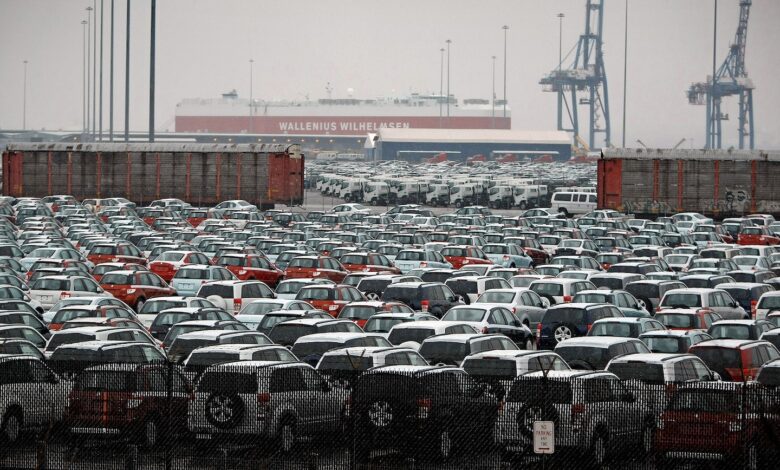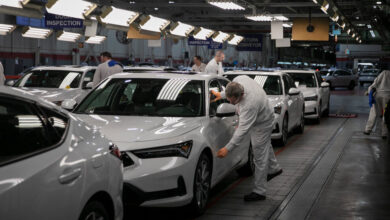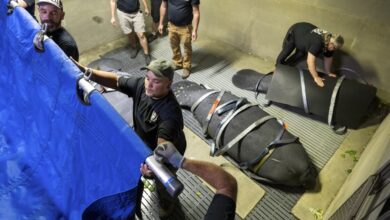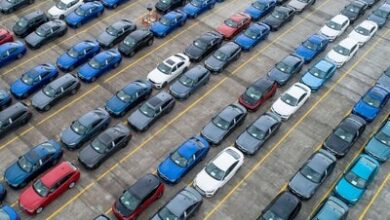How the Baltimore bridge collapse will impact supply chains, economy

Top ten imports and exports to the Port
of Baltimore in 2023
Electronic
machinery,
electronics
Furniture,
bedding,
lights
Electronic
machinery,
electronics
Seeds, grains,
fruits, plants
Air and space
craft, parts
Coal, oil and
natural gas
Note: not seasonally adjusted. Vehicles excluding railways
and tramways. Nickel, aluminium, paper and wood include
derivatives of those commodities

Top ten imports and exports to the Port of Baltimore in 2023
Electronic machinery
and electronics
Machinery,
including
farmwork and
construction
Furniture,
bedding,
lights
Electronic machinery
and electronics
Aircraft,
spacecraft, parts
Seeds, grains,
fruits, plants
Coal,
oil and
natural
gas
Note: not seasonally adjusted. Vehicles excluding railways and tramways. Nickel, aluminium,
paper and wood include derivatives of those commodities

Top ten imports and exports to the Port of Baltimore in 2023
Electronic machinery
and electronics
Electronic machinery
and electronics
Machinery,
including
farmwork and
construction
Aircraft,
spacecraft,
parts
Seeds, grains,
fruits, plants
Coal,
oil and
natural
gas
Furniture,
bedding, lights
Note: not seasonally adjusted. Vehicles excluding railways and tramways. Nickel, aluminium, paper and wood include
derivatives of those commodities
On Tuesday, the Port of Baltimore said that vessel traffic would be suspended in and out of the port until further notice, but trucks would still be processed in its terminals.
“Baltimore’s not one of the biggest ports in the United States, but it’s a good moderate-sized port,” said Campbell University maritime historian Sal Mercogliano. It has five public and 12 private terminals to handle port traffic.

North Locust
Point Marine
Terminal
Baltimore Port
Truck Plaza
Hawkins Point
Marine Terminal

North Locust
Point Marine
Terminal
Baltimore Port
Truck Plaza
Hawkins Point
Marine Terminal

North Locust
Point Marine
Terminal
Baltimore Port
Truck Plaza
Hawkins Point
Marine Terminal
“It does cars, it does bulk carriers, it does containers, it does passengers.” said Mercogliano. “So this is going to be a big impact.”
Baltimore’s the top port in the nation for automobile shipments, having imported and exported more than 750,000 vehicles in 2022, according to the Alliance for Automotive Innovation, an industry group.
About three-quarters of the autos that travel through the port are imports, dominated by big-name brands, including Mazda and Mercedes-Benz. Most of the top companies have enough inventory sitting on U.S. dealer lots that any immediate impact on supply is unlikely, said Ambrose Conroy, chief executive of the consulting firm Seraph.
“It’s too early to say what impact this incident will have on the auto business, but there will certainly be a disruption,” said John Bozzella, president of the Alliance for Automotive Innovation.
The port ranked second in the country for exporting coal last year, according to the state of Maryland. But it’s not a huge global supplier of thermal coal, and the disruption can likely be made up by replacements from Australia or Indonesia if needed, said Alexis Ellender, lead analyst at global trade intelligence company Kpler.
Baltimore is also a niche port for the soybean trade, focusing mostly on high-value soy used in tofu, miso, tempeh and organic products, according to Mike Steenhoek, executive director of the Soy Transportation Coalition. Most of those exports are destined for Asia, but Steenhoek doesn’t expect a big spike in tofu prices because several other U.S. ports also ship this sort of soy, including Norfolk, Va., Savannah, Ga. and Charleston, S.C.
All East Coast ports have become more important in recent years as the United States attempts to boost its trade with friendly nations and reduce geopolitical risks related to trade with China, which generally happens via West Coast ports, said Tinglong Dai, a Johns Hopkins professor and expert on global supply chains.
Baltimore port’s suspension is “one more disruption in an already-stressed system” for the global supply chain, said Abe Eshkenazi, chief executive of the Association for Supply Chain Management. Cargo will now have to be rerouted to other ports, which means figuring out where there is enough capacity to move things.

East coast ports and shipping density
The Port
of Baltimore
5th largest port
on the east coast
for foreign trade

East coast ports and shipping density
The Port
of Baltimore
5th largest port
on the east coast
for foreign trade

East coast ports
and shipping density
The Port of Baltimore
5th largest port on the
east coast for foreign trade
Coal shipments will need to be rerouted to other ports, Kpler’s Ellender said. And Ryan Petersen, chief executive of the logistics company Flexport, posted on X that the company currently has 800 containers on a slew of ships heading for the port that will need to be rerouted, likely to Philadelphia or Norfolk.
The biggest problem Steenhoek sees from Baltimore’s shuttering is the knock-on effect to other ports. Many ships stuck in the port were destined to make stops at other U.S. ports to load and unload goods before heading overseas, a complicated logistical dance now scrambled by the bridge collapse.
“It just shows how you throw a wrench in the supply chain and the impact is not just confined to that one port,” Steenhoek said.
Tim Meko, Justine McDaniel and David J. Lynch contributed to this report. Editing by Kate Rabinowitz and Karly Domb Sadof.



